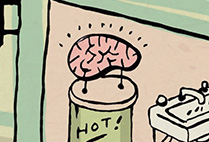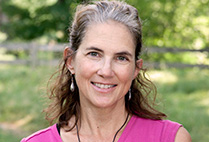There was a good reason that Netta Davis chose to introduce Ben Maleson, commonly known as “the Mushroom Man,” to her Wild and Foraged Foods class with a story.
Earlier that day, Davis (GRS’13), a Metropolitan College lecturer in the gastronomy program, met Maleson outside T. W. Food in Cambridge, Mass., to pick up the mushrooms he had foraged for her class that evening.
While they were talking, a man in a fashionable car pulled up across the street, rolled down his window, and called to Maleson: “You’re the mushroom guy.”
“Yes, I am,” replied Maleson.
“Do you have truffles?” “Yes, yes I do.”
“It was the funniest damn thing,” Davis said, recounting the story as her students, gathered in the demonstration kitchen at 808 Commonwealth Ave., cleaned a wild-mushroom bounty of beefy wine caps, loaf-like porcini, fluted chanterelles, and brainy morels.
This promised to be one of the more hands-on, and tastier, meetings of the MET summer class Wild and Foraged Foods, which tackled the academic side of foraging on Tuesdays and the more experiential side on Thursdays. Lectures touched on the history, science, law, marketing, and culinary approaches to foraging, and were augmented by field trips to Cambridge’s Fresh Pond to forage with local wild food guru Russ Cohen and to Squantum’s Nickerson Beach with science teacher and ecologist (and Davis’ husband) Joel Rubin. Guest lecturers included Maleson and chef Didi Emmons, author of Wild Flavors.
Davis hopes her students learn about wild edible plants and how to forage, but mainly she wants them to “understand why people do it, to think analytically about eating wild and foraged foods and the act of foraging.” The practice has grown in popularity in recent years as consumers concerned about the healthfulness of large-scale food production turn to organic produce, farmers markets, and home gardening.
Davis and her students had just finished mincing shallots and prepping piles of fresh herbs that night when Maleson entered the room. A walking encyclopedia of edible fungi, Maleson knows the Latin, Russian, Japanese, and common English names of hundreds of mushrooms and has foraged and eaten most of them.
Three types of mushrooms are found in the wild, he explained: mycorrhizal, which grow symbiotically on tree roots; saprophytes, which break down dead material; and parasites, which leech from living organisms. He tends to forage for mycorrhizal species, usually looking around oak, balsam fir, and spruce trees. And rotting trees or wood chip piles, he said, are a good source for wine caps.
Maleson recommended buying a good guidebook (he prefers The Mushroom Trailguide by Phyllis Glick or an Audubon Society guide). Because some mushrooms can cause severe reactions—even death—when eaten, he urges newbie foragers to tag along with an expert. Davis also suggested sticking to familiar spots, like personal property and areas removed from highways or industrial sites.
And while Maleson encouraged students to forage, he warned them not to “poach my patch.”


















































Related Stories
Mozart’s Don Giovanni a Wild Ride
CFA stages a tale of sex and revenge, with a score to die for
What That Turkey Is All About
The significance of a Thanksgiving menu, the peril of modification
Chasing Orangutans
Andrea DiGiorgio talks about what big primates eat and why we should care
Post Your Comment